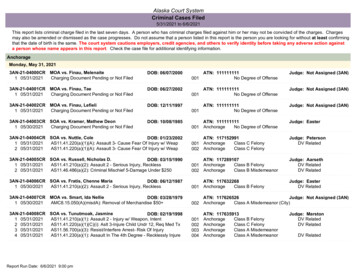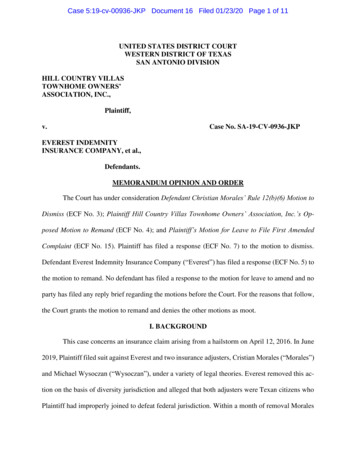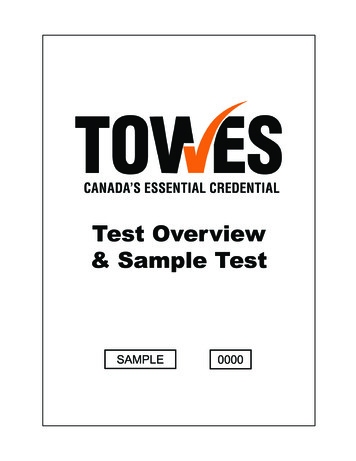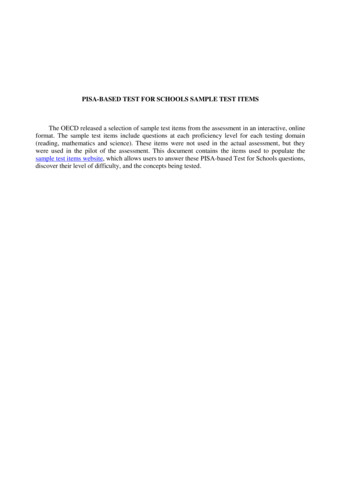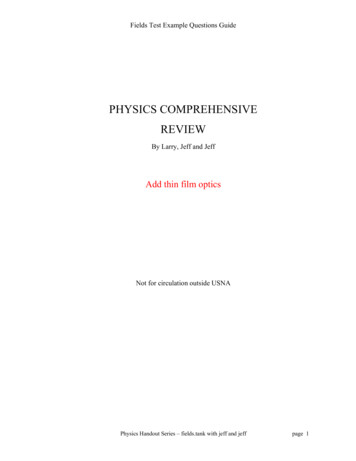
Transcription
Fields Test Example Questions GuidePHYSICS COMPREHENSIVEREVIEWBy Larry, Jeff and JeffAdd thin film opticsNot for circulation outside USNAPhysics Handout Series – fields.tank with jeff and jeffpage 1
Fields Test Example Questions GuideCAUTION: This guide covers 35 problems that will not appear on your Fields Test. Also understand that the guide makes statements that are usually true without adding qualifying remarks orapologies. Advanced or special cases are not treated. In some cases, one or two steps are omitted.Solve each problem as you read through this guide.STRATEGY: The best approach is to recognize the problem and solve it. If you are unsure, findphysical reasons to eliminate as many of the five options as possible. Make an educated guess as youpick from among the remaining options. Mark the problem so that you can return to it later at whichtime you can attempt a more thorough analysis. As you work through the guide, pay special attentionto the examples for which options are found not to be viable.DO NOT MEMORIZE: Memorizing values and facts from this guide is not recommended. Dothink about the concepts and orders of magnitude as you read this guide. Think and read justcarefully enough to be left with a hazy recollection of the experience. THINK, think, think while youtake the test.The sample questions appear boxed. Search for “Ex.” to find the next problem.MECHANICS AND RELATIVITY:Newton’s Laws are best written for particle mechanics. The laws are written in forms appropriate forinertia reference observes. A particle is a body for which every point in the body has the samevelocity. If one considers a rotating billiard ball, there is no one velocity and hence no oneacceleration for all the mass points comprising the ball. The center-of-mass theorems are the bridgethat allows one to generalize Newton’s laws to forms that apply to more general bodies.I.) A particle maintains its state of uniform motion unless acted upon by an (external) force. Uniform motion is motion at a constant velocity v .Physics Handout Series – fields.tank with jeff and jeffpage 2
Fields Test Example Questions GuideII.) The net force that acts on a particle causes that particle to accelerate. The net force is the vectorsum of all the forces that are acting on the particle, and that net force is equal to the mass of thatparticle times its acceleration. (The word causes is of cosmic importance in physics.)III.) If particle A exerts a force on particle B then particle B exerts a force of equal magnitude andopposite direction on particle A. FAB FBANewton’s Third Law deals with forces and particles.General Reciprocity (NOT Newton’s Law, an extension of Newton’s third law): If a physicalentity A exerts an influence on entity B, then B exerts a proportionate counter influence on A. Forexample, an electric charge causes an electric field and an electric field exerts a force on electriccharges. A moving charge creates a magnetic field, and a magnetic field exerts forces on movingcharges. Note that the entities in these examples were not equivalent so the counter influences werenot equivalent. The counter nature is observed when a time-varying magnetic field induces a currentin a conductor. The magnetic field caused by the induced current fights (counters) the variation inthe magnetic field. The magnetic field in the interior of a perfect conductor must be constant in timeas the currents induced in such a conductor are as large as required to completely counter thedisturbing influence. Newton was only setting down laws for forces and particles, not for thesemore complex situations.Newton’s Laws: Use when asked about forces and acceleration at a single position and time. 2Circular Motion: acircle v r rˆ dv dt tˆ 2 r rˆ r tˆThe centripetal part is always in play. The tangential part applies if the speed is changing.Friction: Static friction acts with a magnitude from 0 to s N to keep the contacting surfaces fromslipping relative to one another. Once the surfaces are slipping, the friction force on each surface hasmagnitude equal to k N directed to oppose the relative motion.Factoid: k s.Kinematics, the description of motion, is always in play. It is used in all mechanics problems. Physics Handout Series – fields.tank with jeff and jeffpage 3
Fields Test Example Questions GuideUse Newton’s laws to solve Here & Now problems (related to force and acceleration). Work-Energy: Work is W F dr suggesting that work-energy by used when a change isassociated with a change in position.Mechanical energy: Ei K1 i K2 i UA i UB i .K ½ mi vi2 ½ McmVcm2 ½ Icm 2 ½ McmVcm2 ½ mvrel 2 . .particles iU ½ k (stretch)2 {mgh; - GMm/r} choose near-earth or Universal formEi Wnon-conserve Ef{q V; kQq/r}choose appropriate formWnc-frintion - k N *(distance that surfaces slip relative to one another) A conservative is any force for which the work integral can be evaluated as the difference in thevalues of a scalar function at the integration endpoints. (Can do if the work integral around anyclosed path is zero; curl of the force is zero).Use Work-Energy to solve Here to There ( r) problems.Momentum and Collisions: Impulse is t2t1 F dt suggesting that impulse-momentum methods betried for a change that occurs as time changes – even for the time change from before to after.tf mk vk ,initial Fnet ,external mk vk , final Internal forces do not change the total momentum.tiUse Impulse-Momentum to solve Now to Then (Before to After, t) problems.(1) Collisions:Before to after or now to then problemsRule 1: Conserve momentum vectorially (component by component).Rule 2: Kinetic energy is unchanged for an elastic collision. Some kinetic energy is converted toother forms if the collision is partially or totally inelastic. As the total momentum is conserved, onlythe kinetic energy associated with motion relative to the center of mass is available to be lost(converted).2K total ½ mi vi2 ½ M V 2 ½ mi vrelative, i K CM K relative ; K CM i2Ptotal2MiPhysics Handout Series – fields.tank with jeff and jeffpage 4
Fields Test Example Questions GuideM: total mass; V: speed of the center of mass (CM); vrelative, i : speed of mass i relative to CM.In a totally inelastic collision, the particles stick together so Krelative is lost. KCM remains as requiredby conservation of momentum.Ex. 1) The figure to the left shows twom, 2 voparticles with masses and velocities asindicated. The objects are moving on a flat,frictionless surface. When they collide, the300300objects stick together. Their speed after thecollection is most nearly:(A) 0.67vo(B) 0.87vo(C)2 m, vovo(D) 1.15 vo(E) 1.73voType: Before to After impulse-momentum method collision sub-type Rule 1 is to conserve momentum vectorially so a coordinate system is adopted.Physics Handout Series – fields.tank with jeff and jeffpage 5
Fields Test Example Questions Guidem, 2 voy300x3002 m, vo The momentum of the particles before the collision are p1 m (2v0 )[iˆ ½ ˆj ] and p2 (2 m) v0 [ 3 2 iˆ ½ ˆj ] . The total mass is 3 m and the total momentum is Ptot 4 m v0 [ 4 m v0 [ 3 2 iˆ ] 2 v0 ˆPtotal v final i (inelastic; stick together)D3mM total33232iˆ ] .Was kinetic energy converted to other forms as a result of the collision?The collision was totally inelastic. Was all the kinetic energy lost?(2) Motion in a uniform gravitational field:Ex. 2) Ball 1 is dropped from a height h and ball 2 is dropped form a height ½ h. Which of thefollowing gives the ratio of the speed of ball 1 to that of ball 2 just before they impact? (Assume thatair resistance is negligible.)(A) 2(B) 2½(C) 1(D) 2-½(E) ½First, the problem is a constant acceleration problem. Write down the master equations.x(t) xo vo t ½ a t 2;v(t) vo a t ;v 2 vo2 2 a (x – xo);Physics Handout Series – fields.tank with jeff and jeffvave ½(v vo)page 6
Fields Test Example Questions GuideThe balls fall from rest for a distance H. Using v 2 vo2 2 a (x – xo), v 2 2 g H or v 2 g H .2 g H1v1h v22 g H2½h2BSanity Check. Three answers can be discarded immediately. Which three? Why?If the answer were (A), ball 1 would have twice the average speed of ball 2. What would be the ratioof the fall times in that case given that the first ball falls twice as far? Would you expect them to hitat the same time if dropped at the same time?(3) Law of Universal gravitation:Ex. 3) Two planets of mass m and M respectively have center-to-center spacing R. At what distancefrom the planet of mass M do the gravitational forces of the planets cancel each other. m R (B) 1 m R(A) MM(C)mM R m R(D) 1 M(E)Rm1 MOne need only consider points along the line joining the planets. Why? What must be true about thedirections of two vectors that sum to zero?Prepare a sketch: A large well-drawn sketch provides the greatest benefit. Assume M m.R-dmdRMThe distance from M is sought. Assign the symbol d to that distance.Thought 1: Gravitational forces are attractive. Therefore, the ‘zero – force’ point must be betweenthe planets and along the line joining them. Compare/contrast this situation with that in Ex. 10.Thought 2: The force is an inverse square (with distance) law force.GmGM( R d )2mR d m222MddMd(R d )Physics Handout Series – fields.tank with jeff and jeffpage 7
Fields Test Example Questions GuideThink about the result. At the point where their influences balance, the distance from the smallerplanet is smaller than that from the large planet. (Include sanity checks as you proceed through yoursolution.) Assume m M as you reason through the possibilities,R d mSincemMM d R d 1 mM d 1 RmEMis less than one, d ½ R. The point is farther from the more massive planet. Rereadthe question. The distance d of the point from the more massive M planet is requested. The unknownlabel d is assigned to the value requested. Always review the question to ensure that you haveanswered the question that was asked.Assume m M, say m 0.01 M: Answers A, B, C and D correspond to points closer to M or topoints not between the planets. Why must the correct point be between the planets and be fartherfrom the more massive planet?If you expect d to be greater than ½ R, you might revise the figure to reflect this expectation.METHOD: Try a set of values that simplifies the problem: Midn Jasperson (2011) proposed thatone might just look at the case that m M in which case the equilibrium point should be at the midpoint of the line joining the masses, distance equal ½ R. Only response (E) satisfies that test.(4) Statics and Archimedes PrincipleIn equilibrium, the sum of the forces acting on a rigid body is zero, and the sum of the torques (aboutany axis free to choose it where you wish) acting on the body is zero.A body is buoyed up by the weight of the fluid that it displaces. FB fluid Vdisplaced g.Ex. 4) A metal block is suspended in an empty tank from a scale that indicates a weight of W. Thetank is then filled with water until the block is covered. If the density of the metal is three times thedensity of water, what apparent weight of the block does the scale now read?(A) ½ W(B) 2/3 W (C) W(D) 3/2 W (E) 3 WPhysics Handout Series – fields.tank with jeff and jeffpage 8
Fields Test Example Questions GuideExamine your options. The new reading should be less than the original reading. Answer (B) couldbe chosen without much more as the one third density means that the mass will be buoyed up by 1/3of its weight if completely immersed, but one should solve the problem before choosing an answer.Prepare drawingsT WdryT Wwet wVg mVgWdry m V g 3 w V g mVgWwet m V g - w V g ( m - w) V g* The ratio of the density of a material to that of water is called the specific gravity of the material.Wwet Wdry ( - w/ m) Wdry ( - / )B(5) Simple Harmonic MotionEquation of Motion: x(t) A cos[ t ] C cos[ t ] D sin[ t ]Take derivatives to find expressions for v(t) and a(t).v(t) - A sin[ t ];a(t) - 2 A cos[ t ]Energy Conservation: ½ m v2 ½ k x2 ½ m (vmax)2 ½ k A2 Etotal mechanicalWith the convention that U 0 when the particle is at the equilibrium position, the energy is allkinetic as the particle passes through the equilibrium position and all potential at the turning points. km g I stiffnessinertial property A mass hanging from a linear spring executes simple harmonic motion about its equilibriumposition. Potential energies are associated with systems of interacting entities. Potential energies areassociated with pairs of things (at least) or the system while a kinetic energy can be owned by aPhysics Handout Series – fields.tank with jeff and jeffpage 9
Fields Test Example Questions Guidesingle entity. The potential energy can be shifted by an additive constant. For SHM, it is often set tozero for a particle at the equilibrium position.Ex. 5) A 1-kilogram particle is attached to a spring and exhibits one-dimensional simple harmonicmotion. The particle’s distance (!/* displacement) from the equilibrium position is given by the expression: y(t) A sin[ t /2], where A 1 meter and 0.5 rad/s. If the potential energy of theparticle (system) at its equilibrium position is null (or zero), which of the following gives the totalenergy of the particle (system)?(A) 2 J(B) 1 J (C) ½ J (D) 1/8 Jv(t) - A sin[ t ];vmax A;(E) 0 Ja(t) - 2 A cos[ t ]amax 2 A ½ m v2 ½ k x2 ½ m (vmax)2 ½ k A2 Etotal mechanicalThe total energy is kinetic at equilibrium as the potential is set to zero at that point.½ m (vmax)2 ½ k A2 Etotal mechanicalThe relation v(t) - A sin[ t ] shows that vmax A 0.5 m/s. Using m 1 kg,Etotal ½ m (vmax)2 ½ (1 kg) (0.5 m/s)2 1/8 J.DAlternative: Etotal ½ k A2 ½ (m 2) A2 ½ (1 kg) (0.5 rad/s)2 (1 m)2 1/8 J.Write down the equation that is to be used. Substitute numerical values with units for each symbolwriting the values in the same geometric pattern that was used for the symbols. Adopt proceduresthat reduce the chance of making a careless error.(6) Equilibrium with torquesIn equilibrium, the sum of the forces acting on a rigid body is zero, and the sum of the torques aboutany axis ( free to choose axis where you wish) acting on the body is zero. r F ; r F r F r F sin The displacement from the axis to the point of application of the force is r , CCW is positive, and is the angle that takes you from the direction of r to the direction of F .Physics Handout Series – fields.tank with jeff and jeffpage 10
Fields Test Example Questions Guide Vector cross product: Extend the fingers of your right hand in along the direction of r . Orient your hand so that the fingers can curl toward the direction of F . The thumb of the right hand will be in the direction of r F . F raxis500 rline of action of F Ex. 6) The figure shows a uniform rod of mass 4 kilograms that is pivoted at one end and supportedby a string at the other end. If the rod is at rest (in equilibrium) the tension in the string is most nearly(A) 20 N(B) 26 N(C) 31 N(D) 40 N(E) 62 NUse the figure The rod does not have an assigned length. Assign a length of , 1 m or even 4 m. Ifthe value is not given, the answer must be independent of its value.Choose an axis: The pivot point is a natural choice for the axis. Picture the situation. If the tensionwere changed, about what point would the rod rotate?The tension force tends to cause a CCW ( )½ r T 500 T40400 W0rotation so the associated torque about thepivot is T T sin(400). To computetorque, the weight of the boom can beassumed to be applied at its center of mass.The weight has a lever arm of ½ and tendsto cause a CW rotation. W - W (½ ).The sum of the torques must be zero so:T ½ (4 kg ) (9.8 N kg )½W½mg 30.5 N sin(400 ) sin(400 )sin(400 )Physics Handout Series – fields.tank with jeff and jeffCpage 11
Fields Test Example Questions Guide ½ (4 kg ) (9.8 N kg ).707 20 N 28.3 N.707lost calculator approximate using sine of 450; 40 45 sor smaller and T larger for same r TWe expect an answer larger than 28 N so response (C) is chosen. The actual value is about 30.5 N.(7) RelativityRelative speed vLengths are contracted along the direction of relative motion, but lengths running transverse to themotion are unchanged. 1 (v c) 2; A clock in motion relative to the observer runs slowly. t t1 (v c ) 2If a time t 10 s elapses as measured by a moving clock, and it appears to be running slowly asviewed by the primed observer, then the corresponding interval t is longer than 10 s. Consider a primed observer moving at v iˆ relative to an unprimed observer with the initialconditions that their respective axes are parallel and the origins coincided at t t 0.Adopt the notations: v c and 1 (v c) 2 1 2 .c t [c t x]]y yx [ x cty yz z t 1 tEx. 7) A stick of length L lies in the x-y plane as shown. An observer moving at 0.8 c in the xdirection measures the length of the stick. Which of the following gives the components of thelength as measured by the moving observer?yLxLy(A)L cos 0.60 L sin (B)0.6 L cos 0.60 L sin (C)0.6 L cos L sin (D)0.64 L cos 0.64 L sin (E)0.78 L cos 0.78 L sin L OxPhysics Handout Series – fields.tank with jeff and jeffpage 12
Fields Test Example Questions GuideThe component along the direction of motion should be contracted by a factor of 0.6 while thetransverse length should be unchanged.L x 0.6 (L cos ) ;L y Ly L sin Note that only answer (C) has an unchanged transverse component.CThe following relativity material is under development.There are four vectors, and they all transform according to the same transformation rules (Assumingthe same v iˆ relative velocity and with v c and 1 2 .).V0 [V0 V1 ]V1 [V1 V0 ]V2 V2V3 V3For the position vector, x0 ct, x1 x, x2 y and x3 z. The four-momentum is: (p0, p1, p2, p3) (E/c, px, py, pz). Note the manner in which factors of c are used to ensure that all components have the same dimensions.The transformations ensure that there is an invariant metric product.22222222V0 V1 V2 V3 V0 V1 V2 V3 Invariant interval: s2 (c t)2 - ( x)2 - ( y)2 - ( z)2 (c t )2 - ( x )2 - ( y )2 - ( z )2This result is useful when one considers the interval between two events. If s2 (c t)2 - ( x)2 ( y)2 - ( z)2 is positive, the interval is called time-like and the two events can be causally related. If s2 is negative the events are separated by a distance greater than that which light can travel in atime t , and the interval is called space-like and the two events cannot be causally related. Points ata time-like interval from the current event are in the future and past lightcones of that event and can linked causally to events inside the light cone.Points at a space-like interval form the event are outside the light coneand can not be causally related to the event at the apex of the cones.http://en.wikipedia.org/wiki/Light coneSimilarly: p2 (E/c)2 - (px)2 - (py)2 - (pz)2 (E /c)2 - (p x)2 - (p y)2 - (p z)2When one considers the momentum of a single particle, the invariant p2 can be evaluated in the restframe of the particle with the result that pparticle m c in all frames where m is the mass of the222 particle. The general expression for the moment of a particle is p ( v mc, v m v ) where v is the standard three velocity of the particle, m is the (rest) mass and v 1 (v v c ) 2 .Physics Handout Series – fields.tank with jeff and jeffpage 13
Fields Test Example Questions Guide Using the invariant p2 (E/c)2 - (px)2 - (py)2 - (pz)2 m c2, E2 m2c4 c2 p p Eo2 c2 p pvE2 Eo2 c2 ( v m v)2 Eo2 c2 ( v Eo /c2)2 ( v Eo)2 E v Eo. The kinetic energy of theparticle is the increase over the rest energy. K E E Eo ( v – 1) Eo.Total energy: E v Eo. Kinetic energy: E ( v – 1) Eo ½ mv 3 8 m v24c2 . (small v expansion; binomial) Sample calculations:In one frame, event B occurs 4 s after event A and event B is 1 km from A. In a second frame,event B occurs 5 s after event A. a.) Could event A have caused event B? b.) What is the observeddistance d between the events in the second frame?a.) s2 (c t)2 - ( x)2 - ( y)2 - ( z)2 (3 x 108 m/s * 4 x 10-6 s)2 – (1000 m)2 440000 m2 0The interval is time-like so event A could have caused event B.b.) The interval is invariant so s2 440000 m2 (3 x 108 m/s * 5 x 10-6 s)2 – d2 d 1345 m. An electron has a rest momentum (0.511 MeV/c, 0, 0, 0). a.) What is the electron’s energy when it is ifit is moving at 0.8 c relative to the observer? b.) Assuming that the electron is moving in the positivex direction relative to the observer, what is its velocity if its energy is 1.25 * 0.511 MeV? Using the invariant p2 (E/c)2 - (px)2 - (py)2 - (pz)2 m c2, E2 m2c4 c2 p p Eo2 c2 p pvE2 Eo2 c2 ( v m v)2 Eo2 c2 ( v Eo /c2)2 ( v Eo)2 E v Eo a.) E v mc v Eo [1 – 0.82]-½ 0.852 MeV.b.) E v mc Eo [1 – 2]-½ 1.25 MeV. 1 – 2 1/(1.25)2. 0.6 so v 0.6 c.With the other assumptions, the particle is traveling at 1.8 x 108 m/s in the positive x direction. Alternative solution: p ( v mc, v m v ) (0.511 MeV/c, 0, 0, 0) in the rest frame. Apply thetransformations: p '0 [ p0 p1 ]; p1 [ p1 p0 ], p '2 p2 ; p '3 p3 a.) p c [0.511 MeV/c - (0)] c-1 Eo E Eo( )Attempt to solve b.) using the transformation method.Physics Handout Series – fields.tank with jeff and jeffpage 14
Fields Test Example Questions GuideParticle Decay: Consider a particle of mass M decaying into a particle of mass m and a masslessparticle. Find an expression for the magnitude of the momentum of the particle of mass m.It is assumed that the original particle decays while at rest. Conservation of momentum requires thatm and the massless particle have oppositely directed, equal magnitude (p) momenta in the final state.Energy conservation requires that: Mc 2 m 2c 4 p 2c 2 0 p 2 c 2 .Mc 2 pc m2 c 4 p 2c 2 ; M 2c 4 2Mpc3 p 2 c 2 m 2 c 4 p 2 c 2M c m c 2 Mpc2 4?:2 43 M p 2 m2 c2MWhat is the expression for the energy of a massless particle with momentum p?ELECTROMAGNETISM AND CIRCUITS:(8) Basic Circuits and Circuit ElementsThe three basic passive elements are the capacitor, resistor and inductor. Each is characterized by its1VC ( /C) Q ;voltage rule.Series Combos:Parallel Combos:1Cseries 11 C1 C2Cparallel C1 C2dI1VR I R ; VL L /dt (Note /C in the VC relation.)Rseires R1 R21R parallel Lseries L1 L211 R1 R21L parallel 1 1 L1 L2Study the location C relative to those of R and L in the voltage relations. Note the inverse locationof C in the voltage relations and hence in the rules for series and parallel combinations.The voltage across a capacitor is a continuous function of time. Why?The current through an inductor is a continuous function of time. Why?Kirchhoff’s voltage rule: The sum of the voltages (potential changes) around a closed path is zero.Kirchhoff’s current rule: The algebraic sum of the currents into a node is zero.Elements are in series if the wiring of the circuit requires that the current through the elements isthe same. There can be no branch points between them.Physics Handout Series – fields.tank with jeff and jeffpage 15
Fields Test Example Questions GuideThe voltage across a series combination is the sum of the voltages across the individual elements.Elements are in parallel if the wiring of the circuit requires that the voltage across the elements isthe same. One lead from each goes to a common point and the other two leads from the elementsjoin at another common point (connection path to join of high conductivity).The current through a parallel combination is the sum of the currents through the ia.org/wiki/File:Parallel circuit.svgElements are in parallel if the wiring of the circuit requires that the voltage across the elements is thesame. One lead from each goes to a common point and the other two leads from the elements join atanother common point (connection path to join of high conductivity).Ex. 8) A capacitor of capacitance 125 microfarads is initially charged such that the voltage acrossthe plates is found to be 100 volts. If the capacitor is the connected in series to (with) a pure inductorof inductance 0.2 Henry, what is the maximum value of the current that is observed in the inductor?(A) 1.0 A(B) 2.5 A(C) 4.5 A(D) 5.0 A(E) 10.0 APrepare a sketch:Physics Handout Series – fields.tank with jeff and jeffpage 16
Fields Test Example Questions GuideWhen the switch is closed, the two elements will beconnected in series and parallel. The capacitor initiallyhas a charge Q C VC (125 F)(100 V) 12500 C. C100 VdIQKVR:/C L /dt 0. Using I -dQ/dt,L125 Fd 2Q 1d 2x 2 x 0Q0comparedt 2 LCdt 20.2 HA simple harmonic oscillation at (LC)-½. Q(t) Qi cos[ t ]; I(t) - Qi sin[ t ]The current through an inductor is a continuous function of time. It is zero just before the switch isclosed so it is zero just after it is closed. I(t) - Qi sin[ ] 0 0 and Qi is just Q(t 0) or12500 F. The frequency is (LC)-½ (125 x 0.2 x 10-6 )-½ (25 x 10-6 )- ½ 200 rad/s. I(t) - Qi sin[ t ] Imax Qi (12500 C) (200 rad/s) 2,500,000 A.BThe potential drops as one moves down in bothelements. Note the pattern in which the staticSwitch closed at t 0.charges accumulate on the inductor to cause thedI QC dt d 2Q---dI/dt . Starting at the lower left and proceeding CW,the sum of the potential changes is Q/C – (L dI/dt) 100 V-Qdt 20.2 H0.When the current is in the direction chosen aspositive for dI/dt, the charge Q decreases so I dQ/dt.Better: Recall that an LC circuit is anoscillator.Alternative:dIdt I max maxd 2Q 1 Q 0 dt 2 LC1V100VI max max 500 A I max 2.5 As0.2 HLLC The total electric field is the sum of the electrostatic field and the circulating field E ES EC .Physics Handout Series – fields.tank with jeff and jeffpage 17
Fields Test Example Questions Guide E d S 0 B Ec d t nˆ dA ES VKirchhoff’s law states that the sum of the potential drops is zero. The potential drop between A andB is BA ES d 0 . The electric field in the integral is the electrostatic field only! A terminal toterminal integration path can be adopted to avoid the regions with circulating field contributions. QC100 V-Q b c d a E d 0 E d E d E d E d S S S S S abcd QE d S 0 C ( 0) L dI dt ( 0) 0 ALTRNATIVE: Ex. 8) A capacitor of capacitance 125 microfarads is initially charged such that thevoltage across the plates is found to be 100 volts. If the capacitor is the connected in series to (with)a pure inductor of inductance 0.2 Henry, what is the maximum value of the current that is observedin the inductor?(A) 1.0 A (B) 2.5 A (C) 4.5 A (D) 5.0 A (E) 10.0 AThe energy initially stored initially in the capacitor is all stored in the inductor when the current is amaximum. ½ L Imax2 Qmax2/2C. Imax LC]-½ Qmax (200 s-1) (1.25 x 10-2 C) 2.50 AEnergy methods are more efficient when they work!. Physics Handout Series – fields.tank with jeff and jeffpage 18
Fields Test Example Questions GuideEx. 9) If the V is the potential difference between points IRRand II in the diagram above and all three resistance have thesame resistance R, what is the total current between I and II?I(A) V/3R (B) 3 VR (C) 2V/3R (D) 3VR/2IIR(E) 3V/2R What is not said? The lower conductor continues out of the field of view. The components illustratedare embedded as a unit in some larger circuit.Put the sub-assembly in a circuit and use Kirchhoff’s Laws.RRIIIR Solution: Start with the voltage versus current relation: VR I R. The voltage across a resistor isequal to the current through it times its resistance. The first conclusion is that I V/R for anindividual resistor with each symbol representing its value for that resistor.1st Conclusion: Responses (B) and (D) have incorrect dimensions and so are eliminated.2nd Conclusion: There is a current V/R in the lowest resistor. A smaller current exists in the upperbranch of two resistors. The currents are to be summed. V/R I 2 V/R. They make it rather easyas only response (E) corresponds to a current greater than V/R.ERelated Techniques: When you encounter a network of passive elements, you should make seriesand parallel combinations in sequence to reduce the network. The upper branch resistors arePhysics Handout Series – fields.tank with jeff and jeffpage 19
Fields Test Example Questions Guidecombined in series (What is required for two elements to be in series?) to yield an effectiveresistance of 2R. Then 2R and the R in the lower branch are then combined in parallel to yield a neteffective resistance of 2/3 R. If one is asked about the current, voltages, for individual elements,one should start with the fully collapsed network and find all the values. Next, back out one step (inour case to R and 2R in parallel. Analyze to find all the values. Next, back out one more step andanalyze . .(10) Coulomb’s Law and ElectrostaticsA physics major should know Coulomb’s law, the Biot-Savart law and Maxwell’s equations.equation Gauss’s LawFaraday’s LawGauss’s Law - MagnetismAmpere (Maxwell's 4th)Charge Conservation(Continuity)Lorentz Force Law E (rp ) B(rp ) 04 all rs all rs Vintegral form QE nˆ dA inside 0 V 0dV B nˆ dAE d A A t V B nˆ dA 0 E nˆ dAB d J AA000 t dQ V t dV V J nˆ dA insidedt
take the test. The sample questions appear boxed. Search for “Ex.” to find the next problem. MECHANICS AND RELATIVITY: Newton’s Laws are best written for particle mechanics. The laws are written in forms appropriate for inertia reference observes. A particle is a body

